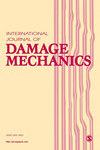Microscale modeling of fatigue crack growth at particle interfaces in viscoelastic asphalt materials
IF 3.9
2区 工程技术
Q2 MATERIALS SCIENCE, MULTIDISCIPLINARY
引用次数: 0
Abstract
The viscoelastic damage evolution at the microscale particle interfaces of asphalt mortar or mixtures fundamentally determines the material's fatigue crack growth and failure at the macroscale. However, existing microscale damage models are often based on empirical assumptions that depend on interparticle stresses or forces, which are inaccurate or even incorrect for viscoelastic asphalt materials. In these materials, interfacial crack growth is governed by the viscoelastic energy release rate. To address the limitations of current models, a microscale viscoelastic fatigue damage model was developed using a pseudo J-integral-based Paris’ law and implemented in a discrete element model of asphalt mortar using the PFC2D program. The viscoelastic constitutive behavior was represented by a generalized Maxwell model, and the relaxation moduli were determined through a uniaxial compressive dynamic modulus test. The Paris’ law coefficients were calibrated by comparing model predictions with experimental results from indirect tensile fatigue tests of the material. The results show that the simulated fatigue life and crack area closely match laboratory test data, with an error margin within 15%. During the simulation of microscopic IDT fatigue damage, cracks hinder the horizontal transfer of forces within the cracked region, leading to stress concentrations in surrounding particles and a marked increase in their relative displacement. The connection of upper and lower cracks significantly reduces the specimen's load-bearing capacity. The variation in the number of contact breaks with fatigue load cycles is unaffected by the type of asphalt but is influenced by the applied stress level. These findings demonstrate that the pseudo J-integral-based Paris’ law, when applied at particle interfaces, can effectively model crack growth at the microscale and accurately predict the fatigue damage performance of viscoelastic asphalt materials at the macroscale.粘弹性沥青材料颗粒界面疲劳裂纹扩展的微尺度模拟
沥青砂浆或混合料微观颗粒界面的粘弹性损伤演化从根本上决定了材料在宏观尺度上的疲劳裂纹扩展和破坏。然而,现有的微尺度损伤模型往往基于依赖于颗粒间应力或力的经验假设,这对于粘弹性沥青材料来说是不准确的,甚至是不正确的。在这些材料中,界面裂纹的扩展受粘弹性能量释放率的控制。为了解决现有模型的局限性,采用基于伪j积分的Paris定律建立了微尺度粘弹性疲劳损伤模型,并使用PFC2D程序在沥青砂浆离散元模型中实现。粘弹性本构行为用广义Maxwell模型表示,松弛模量通过单轴压缩动模量试验确定。通过比较模型预测与材料间接拉伸疲劳试验结果,对Paris定律系数进行了校准。结果表明,模拟疲劳寿命和裂纹面积与实验室试验数据吻合较好,误差在15%以内。在微观IDT疲劳损伤模拟过程中,裂纹阻碍了裂纹区域内力的水平传递,导致应力集中在周围颗粒中,其相对位移显著增加。上下裂缝的连接明显降低了试件的承载能力。接触断裂次数随疲劳荷载循环的变化不受沥青类型的影响,但受施加应力水平的影响。这些结果表明,基于伪j积分的Paris定律在颗粒界面上可以有效地模拟微观尺度上的裂纹扩展,并在宏观尺度上准确预测粘弹性沥青材料的疲劳损伤性能。
本文章由计算机程序翻译,如有差异,请以英文原文为准。
求助全文
约1分钟内获得全文
求助全文
来源期刊

International Journal of Damage Mechanics
工程技术-材料科学:综合
CiteScore
8.70
自引率
26.20%
发文量
48
审稿时长
5.4 months
期刊介绍:
Featuring original, peer-reviewed papers by leading specialists from around the world, the International Journal of Damage Mechanics covers new developments in the science and engineering of fracture and damage mechanics.
Devoted to the prompt publication of original papers reporting the results of experimental or theoretical work on any aspect of research in the mechanics of fracture and damage assessment, the journal provides an effective mechanism to disseminate information not only within the research community but also between the reseach laboratory and industrial design department.
The journal also promotes and contributes to development of the concept of damage mechanics. This journal is a member of the Committee on Publication Ethics (COPE).
 求助内容:
求助内容: 应助结果提醒方式:
应助结果提醒方式:


